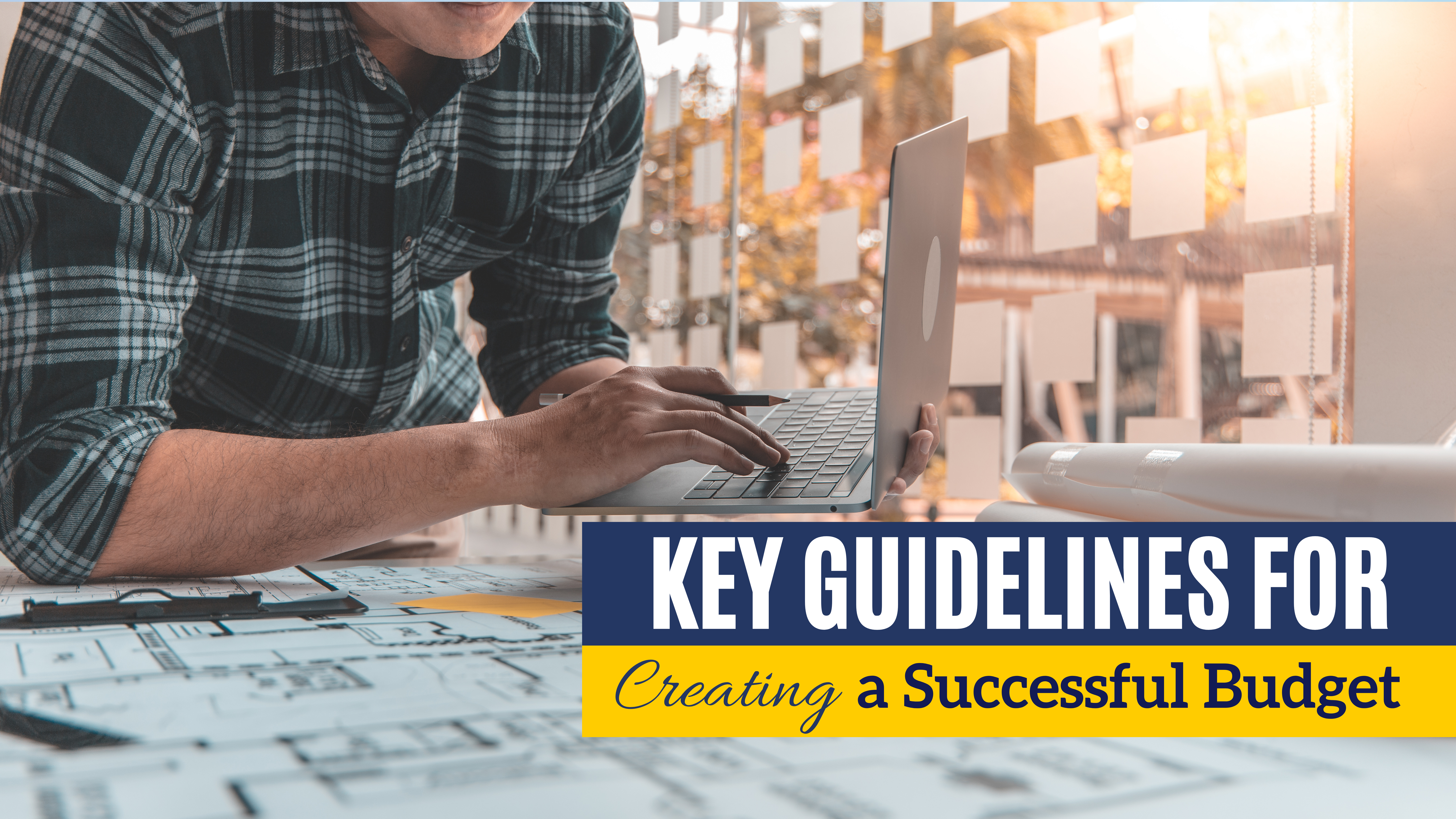Budgeting is like creating a financial roadmap for an architecture project. It outlines all costs, from planning and materials to labour and other expenses. When project managers and architects budget accurately, they can decide where to spend money first and when to purchase things. In this way, the project stays on track financially and is completed within the given deadline. Having a clear budget helps clients understand their financial obligations.
They can see the costs of different design choices and suggestions, which helps manage everyone’s expectations. Being transparent about the terms and conditions can prevent misunderstandings and disagreements in the future. This develops trust between clients and an architect, ensuring the project is completed successfully.

A good budget also helps architects spot any potential overspending early on. This helps them in making modifications to the designs or construction process to stay within budget.
Budgeting isn’t just about money; it’s also about mitigating and managing risks. If financial risks exist at every stage of construction, proper methods of handling them can be adopted. For instance, additional funds can be set aside for unexpected expenses or the use of affordable materials. Accounting services for architects provide solutions to handle finances, including tasks like tax compliance and budget analysis.
Setting Up the Project Timeline
Working on a big project is not an easy task. Creating a project timeline helps determine all the steps you need to take in order. After working on one step you have a plan ready to work on the next step and keep everything moving forward smoothly.
Usually, this timeline is shown visually, so everyone involved can easily understand it. It shows crucial points in the project, like when tasks need to be completed and when the whole project should be done..

Key Guidelines for Creating a Successful Budget
Creating a successful budget for your architectural projects requires careful planning and attention. Here’s how you can do it:
- Learn from Previous Projects: You need to look back at your previously completed projects. Compare your budget estimates with the actual income earned. Did they align well? If you earned more than expected, consider if you can adjust your cost estimates to stay competitive without sacrificing income.
- Explore Templates: While templates can be helpful, not all of them suit your needs perfectly. Look for templates that cover all aspects of budgeting for architectural projects.
- Explore Pricing Methods: There are multiple ways to obtain accurate estimates. Research various pricing methods and select the one that works best for your projects.
- Describe Your Services: Include a detailed list of services you provide in your budget.
By adopting these steps, you can create a financial plan that is both accurate and inclusive, setting your architectural projects up for success. With specialized accounting services for architects, professionals can focus on design and innovation while leaving financial matters in expert hands.
According to the office for National Statistics, effective budgeting plays a crucial role for architects in managing project costs and preventing budget overruns. For example, the sector’s net investment dropped by £8.4 billion to £45.9 billion highlighting the importance of budget control to keep expenses in check.
Essential project budgeting methods for architects
Top-Down Approach: This is like setting a big-picture budget based on experience and knowledge. It is better when you know exactly what the project will involve and how much it will cost, but it should not include the extra spending in case the project changes.
Bottom-Up Budgeting: Here, you divide each task or part of the project to estimated costs. It provides a precise budget, particularly for complex projects, aiding in maintaining tight control of costs at every step.
Parametric Estimating: This technique uses stats and past data to predict project costs based on certain factors. It’s handy for similar projects or when there’s lots of historical data to work with.
Value Engineering: This is about finding ways to reduce costs without compromising quality or function. It involves closely observing the design and construction methods to find smarter, affordable ways to build.
Phased Estimating: Here, you estimate costs at different stages of the project. As the project progresses and you get more info, you adjust your estimates. This is helpful when controlling the costs as well as risks that may arise as the project evolves.
Life Cycle Costing: It involves assessing the expenses associated with operating and upkeep of a building throughout its lifespan rather than solely focusing on the initial costs. This approach aids architects in creating buildings that are not only cost-effective to construct but also financially viable to maintain over time.
You are welcome to consult us in bookkeeping for architects to maintain financial clarity and organization throughout projects.
Common pitfalls in budget management for architects
According to the Office for National Statistics, accurate budgeting is essential for overseeing public sector finances, which experienced a £67.5 billion expenditure growth in 2023 reaching £944.0 billion due to investments in infrastructure and services.
Navigating project budgets can be a bit like solving a puzzle – tricky but doable. Yet, architects often stumble over some common mistakes that keep cropping up:
- Materials Mayhem: One big blunder is underestimating material costs. Architects might forget that prices can change over time. It’s vital to keep an eye on current prices and add a buffer for potential increases.
- Indirect Management: Sometimes, architects can end up focusing on obvious costs like material and labour, overlooking the sneaky expenses. Permits, inspections, and unexpected delays can all throw a wrench in the budget works.
- Contingency Neglect: Forgetting to plan for the unexpected is another pitfall. Weather woes, client changes, or surprise site issues can all eat into the budget. Having a backup fund for these surprises is key.
- Stakeholder Confusion: Architects might sideline important players like clients, contractors, and suppliers during budget talks. This lack of communication can lead to misunderstandings and unhappy faces. It’s essential to loop everyone in from the start.
- Financial Ignorance: Lastly, another common problem that project managers face is the inability to monitor the budget as the project progresses and this may cause extra expenses headaches down the line. Regular check-ins and updates can identify potential problems. Our expert bookkeeping for architects helps in the efficient management of financial processes, allowing you to focus on your design projects.

Tools for architect-led project budgeting
With the right tools, financial management for architects can become a lot easier. Here are some handy ones:
- Budgeting Software (FAS ERP): This software makes budgeting easier and saves your precious time. It can handle calculations, track expenses, and streamline the whole process for you.
- Spreadsheets: Don’t forget about using a spreadsheet. Whether it’s Excel, Numbers, or Google Sheets, these tools let you create custom budgets, input data, and tweak things as needed.
- Cost Estimating Tools: Predicting costs is key, and these tools can help. Whether standalone software or features within project management platforms, they help architects forecast material, labour, and other expenses accurately.
- Project Management Software: Managing budgets is just one part of the puzzle. Project management software like Asana, Trello, or Clickup, can handle budgeting, cost tracking, and much more, tailored specifically for architects.
- Fiscal Evaluation Tools: These tools dive deep into the numbers. They help architects assess the financial health of a project, spot risks, and make informed decisions. Suites like Oracle’s Primavera or SAP’s Business One pack these features in.
With the right tools at your fingertips, project budgeting becomes less of a headache and more of a breeze.
Conclusion
In conclusion, a strong budgeting framework in architecture not only ensures discipline but also strengthens project resilience. By utilizing analytics and AI-powered cost estimation tools architects can enhance accuracy and foresight significantly. Integrating real-time data enables flexible budget adjustments that align with project progress and market changes.
Moreover, promoting education among architects can lead to more innovative and cost-effective design solutions. Prioritizing practices, like obtaining green building certifications can attract eco-conscious clients and provide long-term value. This strategic approach transforms budgeting from a task into a fundamental element of successful architectural practice. For financial advice and further queries please feel free to contact us.
